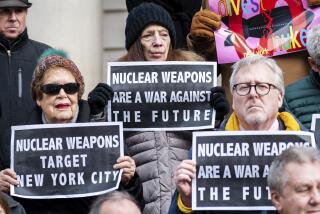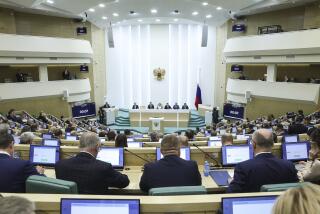U.S. Offers New Plan on A-Tests : Blast Measurement Is Key to Reagan Proposal
- Share via
WASHINGTON — President Reagan disclosed Friday that he has sent Soviet leader Mikhail S. Gorbachev “a new, very specific and far-reaching proposal” on nuclear testing and indicated that it could lead to ratification of two key test ban treaties to which he has previously objected.
A key element in the proposal, details of which were not revealed, is a method of measuring underground nuclear explosions, the only nuclear tests not banned under international agreements.
Although the President described the test measurement system as a “new technical method,” one Administration official, speaking on the condition that he not be identified, said it has been used in monitoring about 100 nuclear tests in the last decade.
No Soviet Reaction
No immediate reaction to the proposal was reported from the Soviet Union.
The proposal was made at the end of a week in which the Soviet Union had offered to refrain from nuclear tests as long as the United States also adhered to such a moratorium.
Reagan’s proposal included a renewed offer to Gorbachev to send representatives to monitor a U.S. nuclear explosion, a proposal that Moscow has previously rejected. The United States, in turn, has rejected the Soviet proposal that it join the Kremlin’s unilateral ban on testing.
Defense Secretary Caspar W. Weinberger said Friday that because the United States relies on its nuclear weapons to deter attack, “there is only one course that is prudent and necessary to pursue, and that is to make sure those weapons work. And you have to do that by having tests.”
In a written statement made public at the White House, Reagan said he was urging the Soviet Union “to join us without delay in bilateral discussions on finding ways to reach agreement on essential . . . improvements” to the methods used to verify compliance with limits on nuclear explosions.
“We are seriously concerned about the past pattern of Soviet testing as well as current verification uncertainties, and have determined that a number of Soviet tests constitute likely violations of obligations under the Threshold Test Ban Treaty of 1974,” he said.
Balked at Ratification
The President has balked at sending to the Senate for ratification the 1974 agreement limiting the size of underground nuclear tests and a 1976 agreement on the peaceful use of underground nuclear explosions. He has asserted that additional procedures are needed to verify compliance with the pacts.
The agreements limit underground nuclear tests to 150 kilotons--the equivalent of 150,000 tons of TNT and 10 times the destructive power of the atomic bomb dropped on Hiroshima in 1945. The United States and the Soviet Union have said they will observe the limit, but each has suggested that the other has violated it.
Reagan disclosed that he had sent to Gorbachev the identity of the U.S. method of measuring the yield of nuclear tests, a system called “Continuous Reflectometry for Radius vs. Time Experiment,” or CORRTEX.
Under this method, an Administration official said, a cable is placed in the hole in which a nuclear explosion is to occur, and a low-energy electrical pulse is sent to the end of the cable and back while scientists measure the amount of time it takes for the pulse to travel the course.
By sending a similar pulse after the blast, scientists can determine the extent of damage caused by the explosion and can then measure its strength.
At Least 100 Tests
The accuracy of this method, the official said, has been checked in at least 100 nuclear tests since the middle 1970s.
To allow the Soviets to examine the system, Reagan said, he invited Gorbachev to send scientists to the U.S. nuclear test site in Nevada during the third week in April, when, the President said, “they could also monitor a planned U.S. nuclear weapons test.”
“In making this offer, I made clear to General Secretary Gorbachev that if we could reach agreement on the use of an effective verification system incorporating such a method to verify” the unratified test agreements, “I would be prepared to move forward on ratification” of the two treaties.
Reagan said the “specificity and concreteness” of the proposal made it unique, along with “the detailed new technical information we have provided to the Soviet Union in trying to solve these verification uncertainties.”
The disclosure of the proposal appeared to reflect the Administration’s concern that Gorbachev had made headway in garnering international public support by freezing Soviet nuclear tests. The Administration has said the Soviets were able to halt their tests because they had completed their planned experiments.
‘Beaten About Head, Shoulders’
“We’ve been beaten about the head and shoulders” by the Gorbachev proposals, an Administration official said.
However, David McKillop, director of the comprehensive test ban task force of the pro-arms control Committee for National Security, said, “I doubt very much the Soviets will fall for this.”
He was quoted by the Associated Press as saying that the last time the United States invited Soviet scientists to observe a nuclear test, the invitation was rejected, and that he expected an even more emphatic reaction this time.
More to Read
Sign up for Essential California
The most important California stories and recommendations in your inbox every morning.
You may occasionally receive promotional content from the Los Angeles Times.










